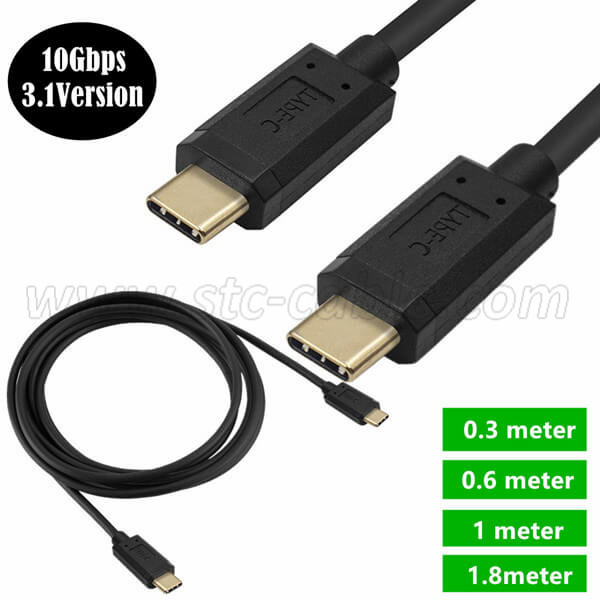What are the advantages of a USB Type-C cable?
USB Type-C, commonly known as USB-C, offers several advantages over older USB standards. Here are the key benefits:
1. Reversible Connector: USB-C has a compact, reversible connector. You can plug it in either way without worrying about orientation, unlike the older USB Type-A connectors.
2. Higher Power Delivery: USB-C supports faster charging speeds than USB-A. It can deliver up to a few hundred watts of power using USB Power Delivery (USB PD). This makes it suitable for charging laptops, phones, and tablets efficiently.
3. Versatility: USB-C is an all-around solution. It can transmit data, video, audio signals, and even PCI-E signals. It’s compatible with various devices, including laptops, smartphones, and external hard drives.
4. Compact Size: The USB-C connector is about a third of the size of the older USB Type-A plug. This smaller form factor is ideal for modern, slim devices.
USB-C simplifies connectivity, provides faster charging, and supports multiple functions. It’s becoming the standard for various devices, replacing older USB connectors.
What is USB Power Delivery?
USB Power Delivery (USB PD) is a charging protocol that enables devices to transfer higher levels of power over a USB connection, significantly speeding up the charging process. Here’s how it works:
1. Higher Power Levels: USB PD allows up to 100 watts of power delivery, which is sufficient not only for smartphones and tablets but also for larger devices like laptops.
2. Voltage Flexibility: When a USB PD charger connects to a device, it performs a “handshake” to determine the power requirements. USB PD supports seven voltage levels: 5V, 9V, 15V, 20V, 28V, 36V, and 48V. The voltage can be dynamically configured to meet the device’s needs, up to the maximum power limit for the standard.
3. Universal Standard: USB PD is a universal fast-charging standard that works across various devices, including smartphones, laptops, tablets, monitors, and docking stations. It eliminates the need for separate power bricks by allowing all these devices to charge over a single USB cable.
USB PD revolutionizes charging by providing higher power levels, flexibility, and compatibility across devices.
How do I know if my device supports USB Power Delivery?
USB Power Delivery (USB PD) is a universal charging standard that allows devices to transfer higher levels of power over a USB connection, significantly speeding up the charging process. Here’s what you need to know:
1. Compatibility: Virtually all devices with a USB port could theoretically be compatible with USB PD, even if not all of them are. Apart from the usual suspects like phones, headphones, tablets, and laptops, more devices support USB PD, including computer monitors, speakers, printers, lamps, and gaming consoles.
2. Check Your Device: To determine if your specific device supports USB PD, follow these steps:
Read the Specifications: Check your device’s specifications or user manual. Look for any mention of USB Power Delivery or PD.
Inspect the Port: If your device has a USB-C port, it’s more likely to support USB PD. However, not all USB-C devices fully implement the standard, so check the documentation.
Trial and Error: Use a USB PD charger (preferably one that supports multiple voltage levels) and see if your device charges faster. If it does, it likely supports USB PD.
Remember that while USB PD chargers work with many modern phones, some devices might not charge as quickly if they don’t fully support the standard. Always verify compatibility based on your device’s specifications.
Can I use a regular USB-C cable for fast charging?
When it comes to fast charging, not all USB-C cables are equal. Here’s what you need to know:
1. USB-C Cable Variants:
Charging-Only Cables: These cables are designed primarily for charging and may not support high-speed data transfers.
Charging + Data Transfer Cables: These cables are optimized for both charging and data transfer. They can handle fast charging rates and allow data to flow efficiently.
2. Factors Affecting Fast Charging:
Power Delivery (PD) Support: Look for cables that explicitly mention USB Power Delivery (USB PD) compatibility. USB PD allows higher power levels for faster charging.
Quality and Construction: Well-made cables with quality materials and proper wiring ensure efficient power delivery.
Device Compatibility: Some devices require specific cables to achieve maximum charging speeds. For example, laptops or high-power devices benefit from 100W or 240W cables.
Using the right USB-C cable ensures efficient fast charging.
Send your message to us:
Post time: Jun-17-2024
